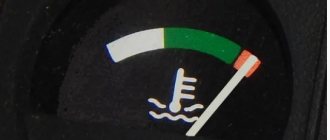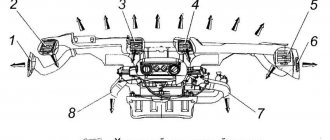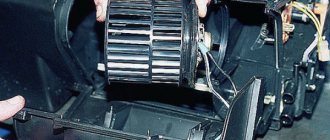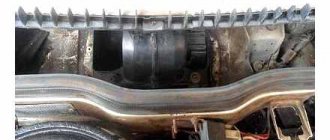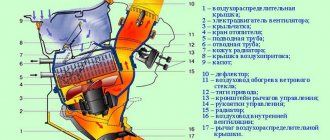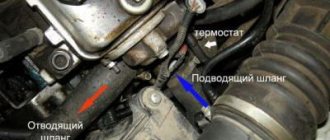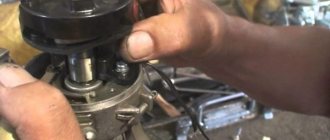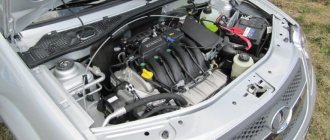Problems with interior heating can arise for various reasons. But they manifest themselves mainly in two indicators:
- The stove blows cold or slightly warm air.
- The stove does not turn on at all or does not work in all modes.
In this article we will look at the possible reasons why the stove blows cold air on a VAZ-2115.
Introduction
Almost all front-wheel drive vehicles of the domestic manufacturer (VAZ) are equipped with high-quality stove heaters that will not allow passengers and the driver to freeze even in severe frost. However, despite this circumstance, it happens that the stove blows cold air. There can be many reasons why VAZ cars are not warm enough during the cold season.
Cold air can only appear at idle, but at the same time, during active movement, the car interior will warm up well. Therefore, if the VAZ-2115 stove does not heat well, you should start solving the problem by troubleshooting, sequentially diagnosing all components of the car.
Cold air into the cabin
This may be due to various malfunctions. What could happen if the VAZ 2115 stove does not work? The reasons are improper replacement of the coolant, depressurization of the cooling system, and a small amount of antifreeze. To remove the plug from the system, you need to remove the heater radiator pipe and add coolant to the maximum. Then start and warm up the engine. The plug will come out on its own under fluid pressure.
Another nuisance is a jammed faucet. This may happen if the valve was not fully opened before, and during operation, scale appeared at its end, interfering with the normal circulation of the coolant. You can unscrew the tap with pliers or replace it.
The fan impeller may be damaged. It should be inspected and, if there is mechanical damage, replaced. If the cabin filter is dirty, then warm air will also not flow into the cabin. The filter needs to be changed.
Heater device
The stove installed on the VAZ-2115 injector is exactly the same as on the earlier “nine”.
The main elements of the heating system are as follows:
- fan;
- radiator;
- air ducts;
- damper rods;
- heater valve;
- resistor;
- motor;
- thermostat.
Coolant, heated from a running 8-valve engine, enters directly into the radiator. The fan blows on the metal plates of the heat exchanger and the air heated in this way enters directly into the interior of the car.
Immediately after the heating circuit is turned on, the heating valve opens and supplies antifreeze to the radiator.
The rods regulate the air supply and the direction of its jets. With their help, you can provide heating to the windshield or direct hot air to frozen feet. By including a resistor in the circuit, it is possible to create a certain resistance, which allows you to regulate the operation of the heater. The thermostat ensures the movement of coolant through two circuits (small and large).
If the last device jams, then the movement of antifreeze occurs only through one of them, which increases the risk of overheating of the power plant. The heating of the car interior is organized through a large cooling circuit. That is, if the thermostat gets stuck on low, heating will not occur.
Often there are also problems with the fan motor. In this case, warm air will not be able to pass through the air ducts and deflectors in the cabin.
As you might guess, in general, the heating system is quite simple, and has previously been used in many other cars. New cars usually do not have any problems of this kind, but over time, as they are used, the chances of a breakdown increase significantly.
Heating system design
Such a system in these cars consists of several components. This is a fan that blows air over the heater radiator. The device also has air ducts and dampers. This is a separate damper for blowing the windshield, as well as a distribution one - it directs the air flow to the central and side deflectors, as well as to the floor. That's not all. There is also a control valve.
You can also highlight the stove faucet and the resistor that controls the power of the motor. There is also a switch that allows you to change the fan power.
If the heating system is working properly, then the coolant heated from the engine is supplied to the heater radiator through the tap. The temperature of the air, which is pumped into the cabin by a fan, can be controlled - this is what the faucet is designed for. Heat is generated when a fan blows on the heater radiator, which is heated by coolant. When the car engine is heated to operating temperature, the temperature of the antifreeze or antifreeze can reach 95 degrees or more.
The stove on this car can operate in one of three modes. Modes allow you to change the fan speed. Depending on the position of the tap, you can supply both warm and cold air into the cabin.
Fan fault
The heater radiator alone, without a fan, will not heat the interior: air circulation is necessary for its effective heating. Fan failure is a rare malfunction, but it is easily diagnosed, so it’s easier to eliminate it right away. It is enough to select the maximum blowing intensity and listen: it is difficult not to hear a fan operating at full power. And the blowing from the air ducts should be noticeable.
If there is a treacherous silence in the cabin, then the culprit for the lack of heat is obvious. Most often, the bearing of the fan fails (announcing its imminent demise with a loud whistle) and the brushes of the electric motor, but a wiring break is also possible. An auto electrician can restore the heater fan.
Causes of malfunction of the VAZ-2115 heater
Since a motorist may not detect the problem immediately, for example, when using the stove only in winter, there may be many reasons why the problem arose. Most often, car owners are faced with a non-working heater motor, a dirty radiator, and the presence of air pockets. Less commonly, problems occur due to a burnt head gasket or a non-functioning heater tap.
The reasons why the heater on a VAZ-2115 does not work may be a simple lack of antifreeze in the radiator or a low performance of the water pump.
Fuse
It’s worth starting to look for the reason from the very beginning. Fuses usually blow. The malfunction is primitive, and you just need to replace the burnt one with a new one. But the fuse failed as a result of a short circuit, and the cause of the short circuit must be found.
This model has two safety blocks. The first can be found under the hood near the left glass, while the second is located in the cabin, under the panel. Two fuse blocks protect the circuits of certain devices.
You can find out which fuse is not working by looking at what is not working yet. For example, if the heater and washer of a VAZ 2115 do not work, then you need to find the fuse that is responsible for the operation of the washers. It is easy to find a burnt element - even an inexperienced driver can easily distinguish a burnt part from a whole one.
Although, due to a non-working heater in these models, there can only be one problem - fuse F7. It is located behind the heater, and the fuse itself is 40 A. It is responsible not only for the operation of the fan, but also for the washer, glove compartment lighting, heated rear window and cigarette lighter.
The stove tap is faulty
The stove may also not work or work, but incorrectly, if its tap is faulty. To correct this problem, you need to tighten a special cable located near the pedal assembly. It is grabbed with pliers and pulled to the side, thereby increasing the tension. The stove tap should open. But if this does not happen, most likely it has oxidized and requires replacement.
Attention! Do not pull the cable too hard, as it may break and all the antifreeze will end up in the cabin.
Preventing the operation of the stove in the car
In order for the stove in your car to heat well and not let you down at the most inopportune moment, you need to follow a few simple tips.
- Keep the radiator clean. Light contamination from the outside of the radiator can be removed with a vacuum cleaner. Flushing the engine cooling system, with which the heater radiator is inextricably linked, will help get rid of internal deposits and blockages in the channels.
- Use good antifreeze . High-quality antifreeze is the key to long-term operation of not only the stove in the car, but also the engine. Remember this and do not forget to replace it in a timely manner.
- Change the cabin filter more often . A clogged cabin filter will certainly create problems not only for the operation of the stove, but also for the air conditioning and cabin ventilation system as a whole. In addition, dust and pollen deposited in the filter can pose a serious health hazard (especially for allergy sufferers).
If, at an outside temperature of minus 25 °C, your car’s heater heats the interior to +16 °C from below and up to +10 °C from above, then it can be considered quite serviceable. To avoid problems, it is recommended to carry out preventive measures in a timely and responsible manner that will allow you to enjoy a comfortable ride in a well-warmed-up car.
And remember, the longer the service life of the machine, the more attention its heating system requires. This applies to all cars, regardless of country and manufacturer.
Heater relay and fuse
A blown fuse is one of the most common faults. Anyone can replace a blown fuse. But determining the reason why it burned out is sometimes not so easy.
Typically, fuses blow because there is a short circuit in the electrical wiring. So, for example, on a VAZ-2115 car the stove is protected by a fuse marked F7 for 30 amperes. By replacing it, you can make the stove heat the car interior again.
Malfunctions and their solutions
Heater motor problems
It is best to start looking for a problem with the heating system if the stove blows cold air on a VAZ-2115. The fact is that in front-wheel drive VAZs, the heater motor most often fails. In order to check its functionality, you should activate the ignition and start the engine. The functionality of the heater motor must be checked on the control unit in all possible positions. At the moment of switching the turntable, the motorist should not hear the sound accompanying the change in speed.
However, among other things, you should pay attention to the operation of the electric motor at maximum speed. If any shortcomings are heard, then the problem may be hidden in a faulty resistor.
If the motor burns out completely or partially, it must be replaced. The reasons that led to the replacement of the electric motor should be eliminated using the recommendations described below:
- First of all, it is necessary to dismantle the decorative trim located on the interior side, then disconnect the black-blue motor wire that powers the device, and get rid of the ground mount.
- After opening the hood, you need to remove the wiper arms and unscrew the frill fasteners. The next step will rid the car of the rubber seal.
- The upper casing of the device can be removed by unscrewing four screws. Then it is important to pull the power wires of the electric motor through the seal, which will allow you to remove the unit itself (the housing will have to be divided in half).
- Once half of the housing with the faulty electric motor has been removed, you can begin to remove the assembly itself.
Further actions include the need to install a new working unit and return the removed parts to their original place.
Cooling system problems
If the stove on a VAZ-2115 stops working, the reasons may be hidden in a malfunction of the cooling system. Most often, with a properly functioning heater motor, the supply of cold air (when hot air is turned on) is caused by an air lock. If the cooling system is airy, you should check the head gasket, as it may have a breakdown. A defective cylinder head makes itself known by splashing out coolant from the expansion tank, shaking the power unit, high temperature displayed on the dashboard sensor, and antifreeze getting into the oil (which causes the latter to become lighter).
First you need to open the hood and check the antifreeze level. If there is not enough coolant, you will have to add it to the required level.
If the interior heater of the VAZ-2115 still does not work, you need to activate the power unit so that you can track the readings displayed on the instrument panel. If the heater does not function as expected, the temperature will not be able to rise to the desired value. The cause of this malfunction may be the valve in the thermostat, which most likely begins to open ahead of schedule.
If the heater on a VAZ-2115 does not work due to a broken cylinder head gasket, then cold air will flow only when the car is running at low speeds. As a rule, when you actively press the gas pedal, the cooling system begins to “break through,” as a result of which the interior of the car is gradually filled with hot air. In such cases, replacing the gasket will help resolve the misunderstanding.
Poorly functioning heater tap
If the heater on a VAZ-2115 car does not work, then the problem may be hidden in the heater tap. If fully or partially closed, hot coolant will not be able to “go” to the radiator. The heater may not be working properly because the faucet has become clogged, causing the damper to stop moving. For prevention, it is enough to activate this element of the system manually at least once a week, opening and closing the tap several times.
To understand why the heater is not blowing well, and at the same time make sure that the faucet is functioning normally, you should compare the temperature of the pipes in the engine compartment and inside the car. When the device is fully opened, they are equally hot. If there is still a need to replace the faucet, then the motorist will have to purchase original components of decent quality.
Clogged heater radiator
If the heater in a VAZ-2115 does not blow due to a clogged heating radiator, then the problem may manifest itself in the form of antifreeze leaks on the carpet under the feet of the passenger sitting in front. To fix the problem, you will have to dismantle half of the interior.
Airlock
If the heater does not blow due to the presence of an air lock in it, then the motorist can independently get rid of it using several simple and accessible methods. The simplest option is to position the vehicle on a hill with the front part forward. Then the car owner will have to open the expansion tank, fill it with coolant to the maximum value, activate the engine and warm it up to operating temperature, while maximizing the speed to 3000. After this, the pipe located at the bottom should be drained, carefully pulling it off so as not to burn your hands. The expansion tank cap must not be closed. After the air that escapes, antifreeze will begin to flow, which will have to be added periodically. After not a single bubble appears when exposed to the pipe, when the heater is turned on, the interior space of the cabin will begin to fill with heat.
Why does the stove heat poorly or not heat?
Below are the main reasons for a poorly functioning or non-functional stove, as well as ways to solve the problem.
- The stove fan does not turn on. The heater fan (interior heater) does not work.
- Thermostat not working. If the thermostat is not working, then it constantly circulates coolant in a large circle, which does not have time to heat up, and as a result, the stove does not heat. You need to check the thermostat and replace it: How to check the thermostat? How to replace the thermostat?
- Airlock. An air lock is formed as follows: after the engine is running, when the coolant cools, air penetrates into the upper part of the radiator, from where it moves to the thermostat. In the morning we start the engine, and the pump circulates air into the interior heater radiator. To remove an air lock, use the corresponding article: How to remove an air lock?. There is also another way: we drop the pipe onto the stove, and slowly add antifreeze there until it is full.
- The stove faucet does not open completely. In 90% of problems with a poorly heating stove, the problem lies precisely in this. In this case, you do not need to tighten the cable of the stove faucet. You need to bend the cable from the gas pedal; when you bend over, you will see it. You just need to use pliers to pull the cable to increase its tension. If the stove faucet does not open, then most likely it has soured and needs to be replaced: How to replace the stove (heater) faucet? If you still try to open it, there is a chance that you will rip it off and flood everything with coolant.
- The heater radiator is clogged. In this case, you need to remove the heater radiator and thoroughly blow it out or install a new one: How to replace the heater radiator?
- Fan impeller. If the heater radiator is hot, then the problem is most likely in the fan impeller. There is a multidirectional impeller.
- Poor quality heater radiator. The fact is that there is a Ukrainian-made heater radiator. This radiator simply does not provide for high heat transfer to the interior by design. Therefore, it is better to use a DAAZ radiator.
- The pump does not create the required pressure. If, for example, the stove does not heat up at idle, and the stove only heats up at speed, then the problem is with the pump. The bottom line is that the pump does not ensure normal circulation of coolant and then the fluid is weak. Similar symptoms are also accompanied by low coolant levels. Instead they put in a duralumin pump, Belmag. There have been a lot of fakes of HEPU lately, so I don’t advise you to use this manufacturer.
- Low coolant level. The coolant level should be at the max mark or a finger higher (in winter).
- There is an option to add an electric pump from Gazelle.
- The cylinder head gasket has burned out. If oh. the liquid smells like gasoline or exhaust; The engine oil smells wow. Liquid; Thick white smoke is coming from the muffler, then the cylinder head gasket has most likely broken.
- The cabin heater filter is clogged. Replace the filter by following the link: How to replace the stove cabin filter?
Also see other useful articles on this topic: The VAZ stove does not work, what should I do?
Warmth in the car interior is an indispensable attribute of a comfortable trip in winter. And in the summer, the stove has its own function of local ventilation.
Like any other device, it can fail. This article will discuss why the stove on a VAZ 2114 does not heat up and how to make the stove heat up better on a VAZ 2114.
As experienced craftsmen say, there can be many reasons why the stove on a VAZ 2114 does not heat well. In order to skillfully and quickly select the right one from all sorts of problems, you need to clearly understand what this heating system is.
It's cold in the VAZ 2114
The stove blows hot
The real mockery of the driver and passengers begins when the heater refuses to switch to cold mode and continues to heat even in 30-degree heat.
Why is this happening and what to do? This situation is almost standard for the classic VAZ family of cars, in which the heater is turned on by an unreliable tap.
However, other much more advanced systems have many places that can lead to the stove constantly producing hot air. Let's sort them all out!
Reason #1: Soggy faucet
This problem, as mentioned above, is the scourge of classic Zhiguli cars. The stove air temperature is switched here using a faucet, one to one, just like in a bathroom. He opened the tap - hot antifreeze filled the radiator of the stove - the heat started.
I closed it - the antifreeze stopped circulating through the radiator, it cooled down, and the air came out cold. But that's if everything works! In fact, the heater valve is switched to the on position with the onset of the first cold weather, and they try to close it in the spring.
After several months of standing in one position, this structure turns sour and refuses to return to the “cold” position. It is often useless to use force - the tap will simply leak. Therefore, the “simplest” solution is to replace the tap.
To avoid this, you need to periodically, at least once a month, move the tap from a cold to a hot position to prevent it from souring during the winter.
Reason No. 2: The damper does not move
Let's leave the Zhiguli alone - in modern car heaters, the temperature of the supplied air is regulated by a damper that directs the air either through the hot radiator or bypassing it. And here there is room for malfunctions to run rampant. Here they are:
— Broken damper rod
If the control of the distribution valve is manual, then a flexible rod is stretched from the handle in the cabin to the valve. It may break and then the damper cannot be moved by a standard turn of the handle (or moving the slider).
The rod itself, as a rule, does not break. The break occurs in the places where it is attached to the control handle and to the damper itself. It is common to apply excessive force to the handle, which leads to the breakage of the mounting lug.
The rod flies out of it, and sometimes it can be very difficult to insert it.
— Malfunction of the electric heater damper drive
The damper can also be controlled electrically. This is, for example, done in the VAZ-2110 and in all cars with climate control. In this case, the drive that moves the damper may simply burn out. If this happened when the damper was in the hot position, the heater will blow hot no matter how and how much you turn the knob on the heater control panel.
In addition to a burnt out drive, there may be other electrical problems. For example, broken wires, oxidized contacts, a damaged contact group in the control handle, or a “glitch” in the electronic climate control unit. In the latter case, you can try to “interrogate” the unit using computer diagnostics, and all other causes are diagnosed with a multimeter.
— Damper wedge
The damper may be jammed by a foreign object. For example, if during repairs you forget a wrench or something like that inside the heater, this may well lead to the heater in the car blowing hot air.
Reason No. 3: Malfunction of the climate control control unit
If the heater is controlled electronically, the source of hot air may be caused by a malfunction of the electronic components. The easiest way to catch such a malfunction is to connect a known-good control unit and check the operation of the stove.
If the temperature begins to regulate normally, the problem is in the block. You can try to repair it or immediately leave a new, working one.
If nothing has changed, you need to look for other reasons why the stove is blowing hot, that is, the electrical and mechanical faults described above.
What to do if the stove only produces hot air?
Diagnosing any malfunctions must begin with a simple one. Therefore, if your car has an electric heater damper, first check its fuse . It is possible that it has burned out or oxidized and is not supplying power to the damper motor.
If the damper is controlled manually, carefully turn the temperature control knob. When the link from the handle to the damper is broken, it turns too easily. If you feel an unusual “emptiness” in your handle, this is a sure sign that something is wrong with your cravings.
This means that you need, at a minimum, to remove the handle and see what caused the traction to break. It is quite possible that you will have to disassemble the heater and look for a break in the damper. Disassembling various parts of the car involves diagnosing other causes of heater malfunction.
If you are not confident in your abilities, then it is better to entrust this work to specialists from a car service center. But, if you prefer to repair your swallow yourself, take a multimeter, the electrical circuit of your car and, having reached the necessary parts, find the reason.
In modern cars, heaters are often hidden deep under the dashboard and require disassembling a huge number of its parts, but the greater the pride in repairing it yourself!
(1
Source: https://russia-avto.ru/remont/salon/pechka-duet-goryachim
Why does the stove blow cold air?
Problems with the operation of the stove in the car interior can be expressed in the following:
- the stove blows cold air;
- the stove starts working if you press the gas pedal;
- the stove blows either cold or hot air;
- air stopped flowing from the deflectors into the cabin;
- the stove works, but cold air enters the cabin;
- fan operation is possible only if the speed regulator is moved to the extreme speed position;
- During operation of the stove, extraneous sounds are heard;
- hot air starts to blow when the crankshaft is running at high speeds.
Due to such malfunctions, not only does the air inside the car not heat up, but the engine as a whole does not function normally, which means the problem deserves special attention.
The reasons why the stove blows cold air can fall into one of two large groups.
1. Malfunctions of the cooling system as a whole.
- Thermostat.
Most often, the reason that the heater in your car is blowing cold air is a broken thermostat or switch. Thanks to this element, the coolant moves in the right direction. If the thermostat fails, antifreeze will pass through the main radiator, the time required to warm up the engine will increase significantly, and if the air temperature is low, it will not warm up.
A malfunction of the thermostat is primarily indicated by the coolant temperature indicator. If the element is faulty, it will take a long time for the antifreeze temperature to rise. In addition, you can feel the hose that comes from the main radiator. If, after warming up the engine, the hose does not heat up and the heater blows cold air, then we can conclude that the thermostat has failed and needs to be replaced.
- Water pump.
Another reason that the stove is blowing cold air may be the ineffective operation of the pump - the pump that pumps antifreeze. Pump failure is possible in the following cases:
— malfunction of its drive (belt break);
— jamming (bearing failure);
- rotation of the impeller (blades that drive coolant) or its destruction, as a result of which it will not be able to effectively pump coolant.
Recommended articles to read:
- Repair Citroen C4 sedan: diagnostic tips
- Automatic transmission Citroen C4 sedan: operating instructions
- Selling a Citroen: how to do it most profitably?
As a result, the system will not warm up evenly - if one part overheats, the other will remain cold, which will lead to overheating of the engine. The antifreeze temperature sensor will indicate a malfunction.
If the pump is ineffective, the heater will operate at high engine speeds. The volume of coolant passing through the radiator at idle speed will not be enough for warm air to blow from the stove.
- Cylinder head gasket.
A nailed or burnt gasket, which is located between the cylinder block and its head, allows gases in the cylinders to enter the coolant.
This malfunction can be judged by white smoke coming out of the exhaust pipe, a sharp increase in the level of antifreeze, as well as gurgling sounds in the expansion tank. This malfunction is quite serious and requires disassembling the engine.
- Air in the system.
The operation of the heater at high engine speeds indicates the presence of air in the cooling system. Air has low thermal conductivity and is therefore not suitable for the rapid spread of heat. This situation adversely affects not only the operation of the stove, but also the functioning of the engine as a whole.
Due to the design features of the stove, air accumulates in the area of its radiator. If the antifreeze does not move intensively enough, for example, when the engine is idling, the coolant does not expel air from the radiator, and the heater blows cold air.
The entry of air into the system is indicated by poor operation of the heater at low speeds, and when they increase, you will not only feel a blow of hot air, but also gurgling sounds in the area of the stove. First of all, the cause of air entering the system should be determined. This may be due to insufficient tightness of the system, leading to air suction, or to a small volume of antifreeze. But before bringing its quantity to normal, it is important to find out and eliminate the reason for the decrease in its volume.
If the heater's radiator has been replaced, but it continues to blow cold air, air has most likely entered the system. To resolve this problem, please refer to the operating instructions for your specific vehicle. To eliminate the air lock that has formed in the heater radiator, it is necessary to disconnect the hoses, then pour coolant into the upper one, while it will pour out through the lower one. The procedure must be continued until air bubbles stop coming out of the hose.
On a number of cars, you can get rid of air in the heating system by placing the car at a certain angle and starting the engine at high speeds.
2. Malfunctions of the heating system.
If the heater blows cold air while running and there are no faults in the cooling system, most likely the problem is in the heater itself. That is, the coolant reaches it, but cannot penetrate into the cabin in the form of hot air. The malfunction may concern the radiator or heater tap.
- Heater radiator.
If the heater blows cold air at speed, the problem may be a clogged heater core. The blockage prevents hot coolant from passing through it, therefore the air does not heat up. This situation is possible in the following cases:
— use of various cooling system sealants;
— long-term operation of the car using low-quality antifreeze or water;
— the car and radiator are of considerable age.
The listed reasons lead to the accumulation of dirt in the cooling system. Since the channels in the stove radiator are the narrowest (due to the need for slower fluid flow and greater heat transfer), they are most susceptible to contamination. The problem can be corrected by flushing or replacing the radiator.
- Faucet.
Another reason that the heater is blowing cold air may be a closed heater tap. This problem occurs in older cars. The situation is possible if there is a malfunction of the faucet itself, which is stuck in the closed position, or in the control drive.
In the latter case, the reason lies in the drive (cable) coming off the mounts. In this case, it must be returned to its place and secured. The faucet is replaced as an assembly. Modern vehicle models do not have faucets; they are equipped with dampers that close the radiator when there is no need for hot air. If the damper fails, the stove also stops functioning normally.
Cooling system malfunctions
Problems with the engine cooling system disrupt its temperature regime, and “in the company” the operation of the stove may also deteriorate. Therefore, if the heater behaves inappropriately (if the cabin suddenly becomes too hot or too cold), first of all you need to look at the engine temperature: perhaps it is far from normal.
One of the most common problems is a stuck thermostat. Depending on the position in which it sours, antifreeze will circulate only in a large or small circle of the system: the engine can either overheat or, conversely, remain cold for too long. In the latter case, the stove will not work well.
A worn water pump also impairs the efficiency of the entire cooling system, including the heater. Over time, low-quality antifreeze literally “eats” the pump impeller, and the liquid does not circulate well through the system. Poor operation of the stove against the backdrop of engine overheating is a clear sign of pump wear and lack of circulation: hot antifreeze is poorly removed from the engine, and cooled antifreeze remains in the heater.
Diagnosis of heating system faults
Heating system malfunctions are accompanied by the following symptoms:
- the fan does not work;
- cold air enters the cabin;
- the damper does not work;
- there is a coolant leak;
- the stove begins to make uncharacteristic sounds (whistles, hums, gurgles);
- Steam or smoke appears from the heater ducts.
Why the stove does not work or does not heat the air
If the stove fails, it either does not work at all, or it works but does not heat the air. In the first case, first check the fan wiring, starting with fuse F7. If the fuse is blown, replace it. Then they check the relay, which may not turn on the first time or only when the engine is warm. In this case, the relay is replaced with a new one.
Then the serviceability of the electric motor is assessed. To do this, power is directly supplied to its contacts from the battery. If the electric motor starts to operate at maximum speed, then it is in good condition. Otherwise, it will need to be repaired or replaced.
The intensity of the air flow is adjusted using a resistor having two spirals with resistances of 0.82 Ohm and 0.23 Ohm. In the first mode, the current flows through both spirals, in the second - only through a spiral with a resistance of 0.23 Ohms, in the third - bypassing the spirals, that is, without resistance at all. If the resistor is faulty, the fan will only operate in the third mode at maximum speed (handle in the extreme right position). The problem is solved by replacing the resistor, which is located on the driver's side above the accelerator pedal.
If the resistor is faulty, the heater fan will only be able to operate at maximum speed.
If cold air enters the cabin, this may be due to:
- Airlock. It could have formed when replacing the coolant, when the system was depressurized, or because there was insufficient amount of coolant in the system. To remove the plug, remove the heater radiator pipe, use a watering can to add antifreeze to the maximum and put the hose back in place. After starting the engine, coolant under pressure will displace the remaining air from the system.
- Stove tap jammed. This happens if the tap was not initially opened all the way, and during operation, oxide and scale formed on the inner surface, preventing the normal circulation of the liquid. You can try to open the tap using pliers or immediately replace it with a new one.
- The stove radiator is clogged. When using low-quality coolant, the radiator honeycombs may become clogged. The problem is solved by flushing or replacing the heat exchanger. The feasibility of washing is determined by the scale of contamination.
- Installation of a low-quality radiator. In a defective product, the honeycomb may be incorrectly soldered. The radiator should be replaced.
- Low pressure in the cooling system. If heat transfer increases at higher speeds, the pump needs to be replaced.
- Low coolant level. It is necessary to check the level and add antifreeze if necessary.
- Damage to the heater fan impeller. The impeller is carefully inspected and replaced if mechanical damage is detected.
- Cabin filter dirty. If it is heavily polluted, the power of the electric motor will not be enough to pump warm air into the cabin. The filter is replaced with a new one.
- Damage to the cylinder head gasket. If the cylinder head gasket is blown, white smoke will come out of the exhaust pipe. The problem is solved by replacing the gasket and dismantling the cylinder head.
Heater dampers don't work
The distribution of air flows throughout the cabin is carried out by dampers, which, in turn, are controlled using cables. When these cables fail, problems arise with directing the air flow to the windshield or to the foot area. In addition, the damper that blocks the flow of air from the street begins to work incorrectly. In this case, adjustment of the damper drives is required.
Such situations can arise even on a new car. Slightly warm air begins to flow from the lower, upper and side deflectors, and hot air begins to flow from the center console. This is due to the poor build quality. There are gaps between the joints of the air ducts and the dampers, which leads to warm air entering only from the center console and heating the panel from the inside.
The drive cable is always taut. Therefore, over time it bends, breaks off or stretches. In this case, it is necessary to adjust the damper drive, which is performed in the following order:
- In the stove, we look for a bracket with which the cable sheath is held on the heater body.
- A galvanized metal lever located on the left side is pulled back. This position corresponds to the maximum opening of the damper.
- The length of the cable is tightened and adjusted. The long lever on the lever block in the extreme right position should open the damper completely.
- After adjustment, the cable is securely fixed.
Video: stove repair using the example of a VAZ 2114
Why is antifreeze leaking from the stove?
A coolant leak in the heating system can occur from:
- stove radiator;
- stove tap;
- stove pipes.
If a coolant leak occurs from the radiator, it is usually replaced with a new one. Repairs to restore tightness are usually complex and labor-intensive. In addition, if the radiator has been in use for a long time, its tubes become clogged with deposits and dirt, and, as a result, heat transfer decreases.
Replacing and connecting the stove
Installing a new heater radiator is done in the reverse order. When installing rubber hoses, it is recommended to treat them with sealant. When connecting electrical connectors, use the markings applied during disassembly.
After assembly, coolant is poured into the system. To prevent an air lock from forming, remove the hose from the throttle assembly after loosening the clamp. Antifreeze should be poured into the expansion tank slowly, observing the disconnected hose. As soon as coolant flows out of it, the hose should be put back on the fitting and tighten the clamp. If everything is done correctly, the operation of the stove will not cause any complaints.
When installing a new heater radiator, it is recommended to pre-treat the pipes with sealant
Video: dismantling the VAZ 2114 stove
Heater radiator repair
Usually, if mechanical damage is detected, the stove radiator is replaced with a new one. However, some car owners try to repair cracks and holes using soldering. A copper radiator is quite easy to solder, and it is much easier to restore than an aluminum one. To repair an aluminum heat exchanger, you will need special flux and tinning solder, as well as a powerful soldering iron. The damaged area is first cleaned of dirt and degreased. Then flux and solder are applied to it with a soldering iron. After soldering, it is recommended to check the radiator under pressure to make sure there are no leaks.
